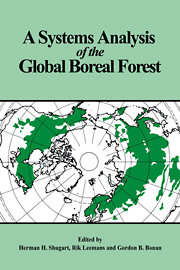Book contents
- Frontmatter
- Contents
- List of contributors
- 1 Introduction
- Part 1 Processes in boreal forests
- Part 2 Patterns in space and time in boreal forests
- Introduction
- 7 The transition between boreal forest and tundra
- 8 The southern boreal–northern hardwood forest border
- 9 Transitions between boreal forest and wetland
- 10 Remote sensing technology for forest ecosystem analysis
- 11 The nature and distribution of past, present and future boreal forests: lessons for a research and modeling agenda
- Part 3 Computer models for synthesis of pattern and process in the boreal forest
- References
- Index
7 - The transition between boreal forest and tundra
Published online by Cambridge University Press: 12 January 2010
- Frontmatter
- Contents
- List of contributors
- 1 Introduction
- Part 1 Processes in boreal forests
- Part 2 Patterns in space and time in boreal forests
- Introduction
- 7 The transition between boreal forest and tundra
- 8 The southern boreal–northern hardwood forest border
- 9 Transitions between boreal forest and wetland
- 10 Remote sensing technology for forest ecosystem analysis
- 11 The nature and distribution of past, present and future boreal forests: lessons for a research and modeling agenda
- Part 3 Computer models for synthesis of pattern and process in the boreal forest
- References
- Index
Summary
Introduction
The boreal forest and the Arctic tundra are two major biomes which cover a total of 30 million square kilometers in the Northern hemisphere. They are characterized by contrasting dominant life forms and productivity levels associated with the presence of trees in the boreal forest and their general absence in the Arctic tundra. The same general differences exist between forest and grassland but the ecological factors responsible for the position of the forest–grassland transition zone are likely to differ from those operating for the boreal forest–tundra transition zone. A causal explanation of the climate–vegetation pattern of the northern forest border is as yet obscured by the poorly known ecophysiology of the tree species (Oechel & Lawrence 1985). Despite the lack of knowledge of the exact mechanism involved, there is general agreement that thermal characteristics of the climate are of major importance in determining the northern edge of the boreal forest. Somewhere at the interface between boreal forest and tundra, tree species face severe climatic conditions, which reduce their growth and development. This induces changes at the plant population and community levels, which can be observed in the transition zone between these two biomes. Forests of this boundary area are likely to be sensitive to environmental changes and often display low regenerative capacity. Various types of ecological alteration, for example climatic changes and wildfires, take place over a wide range of areal dimensions and in different periods. These result in a temporal and spatial vegetation patterning typical of the northern forest border.
- Type
- Chapter
- Information
- A Systems Analysis of the Global Boreal Forest , pp. 196 - 215Publisher: Cambridge University PressPrint publication year: 1992
- 24
- Cited by



